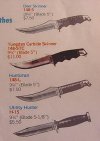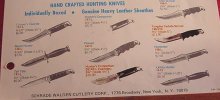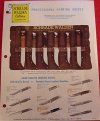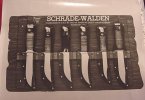Codger_64
Moderator
- Joined
- Oct 8, 2004
- Messages
- 62,324
It has been a long time since I entertained you with a research rant (a couple of days anyway), so I thought I might post one this morning on a subject I've only seen broached in passing here previously. If anyone has other examples they would care to post, or other info to add, corrections to make, I'd surely like to see it.
The Baer brothers were cutlery innovators, introducing new blade shapes, materials, and types that helped them win a top position in the U.S. cutlery market for many years. While many of their innovations have since become industry standards, some ideas failed to work, either because of expense in manufacture, failure in application, or just failure to catch the public’s imagination and were therefore just ahead of their time, like Tucker’s automobile.
One such idea was the use of laminated woods for a handle material (first called Stratawood, then WondaWood), and the now-uncommon Wonda-Edge scalloped or serrated blades.
Another such idea was shown with the 148STC in 1967. Of course, Henry knew that catchy names and slogans helped sell, so the “TC” blades were called “EverLast Edge”, and that trademark was etched on the blades. Evidently the process caught the eye of the Baers, and they wanted to give it a try.
Coating the blades with Tungsten Carbide was not an entirely new idea, as research indicates that the Robeson “ FlameEdge” was done by a process patented in 1955 ( patent 2,714,563), and involved coating a portion of the blade with Tungsten Carbide by firing it at the blade from a “gun” at high speed and pressure. Robeson used the “flameEdge” coating on a line of Kinfolks branded knives in the late fifties/early sixties. Kinfolks went out of business about 1951 and it’s name had been acquired by Robeson.
Due to the complexity of the process, I doubt that either Robeson or Schrade did this coating inhouse, but likely sent it out to a vendor like Union Carbide. Schrade likely purchased licensed rights for use of the process from the patent holder.
By this late date, the advantages (and disadvantages) of TC coatings are well known by anyone familiar with tools, and all sorts of cutting edges are now employing tungsten carbide, from drill bits, saw blades, industrial cutters, even surgical instruments and knife sharpeners.
Tungsten carbide is much harder than the base metals used in knife blades and, as in other tool use, remains sharper longer that the bare base metal. In the case of these knives, the coating is only on one side of the blade (appx. 1/4" wide on the lower bevel). As the knife is used, the base metal (carbon or stainless steel) is worn away, but the thinner tunsten carbide coating remains, in effect “self sharpening” the blade, as well as reducing wear to the base metal. Sharpening is therefore done only to the base metal side.
I recently acquired my first example of the EverLast Edge knives, a Schrade Walden 148STC rigid blade Deer Skinner knife, which happened to be a Sears Ted Williams signature knife as well. I would say that even in it’s standard Schrade Walden form with the jigged Staglon handle and TC coated blade, this knife was top of the line for the year 1967, shown retailing for $8.75 when the standard 148S listed at $4.75 and the more traditional leather handled 148L listed at $5.00. Adding a Gaucho sheath brought the price of the standard 148STC up to a whopping $15.00, the same as the relatively new 15OT Deerslayer that year.
Sears, as they often did in those days, added a few unique details (Ok, “pimped” to their SFO versions of the already fancy 148STC (though they were not yet ordering custom tangstamps), in that the Ted Williams signature was added to the blade etch “Everlast Edge” over “Tungsten Carbide”, a decorative series of three additional spacers was added to the thin flat brass guard (black, brass, red ..making it now 1/4" thick), and matching spacers added to the pommel. Rather than place this special knife in the plain jane flat riveted and stitched sheath with belt slots in the single ply hanger, it came in a thick, deeply embossed folded or “tubular” sheath with the double ply folded over belt hanger.
to their SFO versions of the already fancy 148STC (though they were not yet ordering custom tangstamps), in that the Ted Williams signature was added to the blade etch “Everlast Edge” over “Tungsten Carbide”, a decorative series of three additional spacers was added to the thin flat brass guard (black, brass, red ..making it now 1/4" thick), and matching spacers added to the pommel. Rather than place this special knife in the plain jane flat riveted and stitched sheath with belt slots in the single ply hanger, it came in a thick, deeply embossed folded or “tubular” sheath with the double ply folded over belt hanger.
I have only noticed so far one other pattern from Schrade Walden using the TC edge, the 147STC "Pioneer", also listed in 1967, and discontinued after 1969, whereas the 148STC was last listed in 1971, so there was not a lengthy production of the tungsten carbide coated blades in either pattern. I have not noted any folding Schrade Walden knives using the EverLast Edge, though BRL notes that Robeson did use their TC coating on some folders.
As has been noted with the previously mentioned Wonda-Edge blades, consumer unfamiliarity with the one-sided sharpening technique for these knives may have led to their short production life. Since the example I have is mint, I cannot deduce anything about the wear characteristics of the coated blades, and I am hesitant to hit the uncoated side with a hone to test the recommended. Afterall, when a fairly uncommon hunting knife survives nearly forty years without some nimrod hitting it the full width of the blade with a coarse stone, it deserves a bit of respect, IMHO!

NOTE: What appears to be rust on the TC edge is factory oil

Here is a more standard later 148L SFO for Sears Craftsman (X-393)


And here is a string of posts from BRL on the TC use on knives:
http://pweb.netcom.com/~brlevine/carbid.txt
Codger
The Baer brothers were cutlery innovators, introducing new blade shapes, materials, and types that helped them win a top position in the U.S. cutlery market for many years. While many of their innovations have since become industry standards, some ideas failed to work, either because of expense in manufacture, failure in application, or just failure to catch the public’s imagination and were therefore just ahead of their time, like Tucker’s automobile.
One such idea was the use of laminated woods for a handle material (first called Stratawood, then WondaWood), and the now-uncommon Wonda-Edge scalloped or serrated blades.
Another such idea was shown with the 148STC in 1967. Of course, Henry knew that catchy names and slogans helped sell, so the “TC” blades were called “EverLast Edge”, and that trademark was etched on the blades. Evidently the process caught the eye of the Baers, and they wanted to give it a try.
Coating the blades with Tungsten Carbide was not an entirely new idea, as research indicates that the Robeson “ FlameEdge” was done by a process patented in 1955 ( patent 2,714,563), and involved coating a portion of the blade with Tungsten Carbide by firing it at the blade from a “gun” at high speed and pressure. Robeson used the “flameEdge” coating on a line of Kinfolks branded knives in the late fifties/early sixties. Kinfolks went out of business about 1951 and it’s name had been acquired by Robeson.
Due to the complexity of the process, I doubt that either Robeson or Schrade did this coating inhouse, but likely sent it out to a vendor like Union Carbide. Schrade likely purchased licensed rights for use of the process from the patent holder.
By this late date, the advantages (and disadvantages) of TC coatings are well known by anyone familiar with tools, and all sorts of cutting edges are now employing tungsten carbide, from drill bits, saw blades, industrial cutters, even surgical instruments and knife sharpeners.
Tungsten carbide is much harder than the base metals used in knife blades and, as in other tool use, remains sharper longer that the bare base metal. In the case of these knives, the coating is only on one side of the blade (appx. 1/4" wide on the lower bevel). As the knife is used, the base metal (carbon or stainless steel) is worn away, but the thinner tunsten carbide coating remains, in effect “self sharpening” the blade, as well as reducing wear to the base metal. Sharpening is therefore done only to the base metal side.
I recently acquired my first example of the EverLast Edge knives, a Schrade Walden 148STC rigid blade Deer Skinner knife, which happened to be a Sears Ted Williams signature knife as well. I would say that even in it’s standard Schrade Walden form with the jigged Staglon handle and TC coated blade, this knife was top of the line for the year 1967, shown retailing for $8.75 when the standard 148S listed at $4.75 and the more traditional leather handled 148L listed at $5.00. Adding a Gaucho sheath brought the price of the standard 148STC up to a whopping $15.00, the same as the relatively new 15OT Deerslayer that year.
Sears, as they often did in those days, added a few unique details (Ok, “pimped”
I have only noticed so far one other pattern from Schrade Walden using the TC edge, the 147STC "Pioneer", also listed in 1967, and discontinued after 1969, whereas the 148STC was last listed in 1971, so there was not a lengthy production of the tungsten carbide coated blades in either pattern. I have not noted any folding Schrade Walden knives using the EverLast Edge, though BRL notes that Robeson did use their TC coating on some folders.
As has been noted with the previously mentioned Wonda-Edge blades, consumer unfamiliarity with the one-sided sharpening technique for these knives may have led to their short production life. Since the example I have is mint, I cannot deduce anything about the wear characteristics of the coated blades, and I am hesitant to hit the uncoated side with a hone to test the recommended. Afterall, when a fairly uncommon hunting knife survives nearly forty years without some nimrod hitting it the full width of the blade with a coarse stone, it deserves a bit of respect, IMHO!

NOTE: What appears to be rust on the TC edge is factory oil

Here is a more standard later 148L SFO for Sears Craftsman (X-393)


And here is a string of posts from BRL on the TC use on knives:
http://pweb.netcom.com/~brlevine/carbid.txt
Codger






